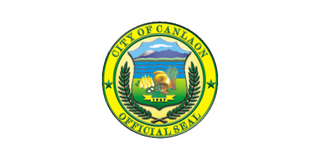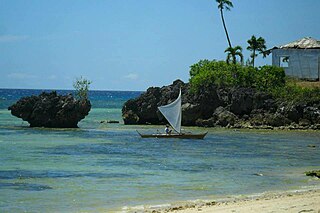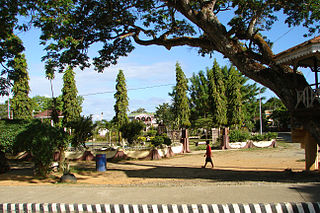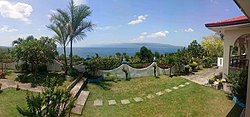
Canlaon, officially the City of Canlaon, is a 4th class component city in the province of Negros Oriental, Philippines. According to the 2020 census, it has a population of 58,822 people.

Tanjay, officially the City of Tanjay, is a 4th class component city in the province of Negros Oriental, Philippines. According to the 2020 census, it has a population of 82,642 people.

Ayungon, officially the Municipality of Ayungon, is a 2nd class municipality in the province of Negros Oriental, Philippines. According to the 2020 census, it has a population of 47,102 people.

Manjuyod, officially the Municipality of Manjuyod, is a 2nd class municipality in the province of Negros Oriental, Philippines. According to the 2020 census, it has a population of 44,799 people.

Siaton, officially the Municipality of Siaton, is a 1st class municipality and the southernmost settlement in the province of Negros Oriental, Philippines. According to the 2020 census, it has a population of 83,082 people.

Sibulan, officially the Municipality of Sibulan, is a second class municipality in the province of Negros Oriental, Philippines. According to the 2020 census, it has a population of 64,343 people.

Tayasan, officially the Municipality of Tayasan, is a 3rd class municipality in the province of Negros Oriental, Philippines. According to the 2020 census, it has a population of 38,159 people.

Zamboanguita, officially the Municipality of Zamboanguita, is a 4th class municipality in the province of Negros Oriental, Philippines. According to the 2020 census, it has a population of 29,569 people.

Dalaguete, officially the Municipality of Dalaguete, is a 1st class municipality in the province of Cebu, Philippines. According to the 2020 census, it has a population of 74,596 people.

Dumanjug, officially the Municipality of Dumanjug, is a 3rd class municipality in the province of Cebu, Philippines. According to the 2020 census, it has a population of 57,823 people.

Ginatilan, officially the Municipality of Ginatilan, is a 5th class municipality in the province of Cebu, Philippines. According to the 2020 census, it has a population of 16,906 people.

Ronda, officially the Municipality of Ronda, is a 5th class municipality in the province of Cebu, Philippines. According to the 2020 census, it has a population of 21,005 people.

Sibonga, officially the Municipality of Sibonga, is a 3rd class municipality in the province of Cebu, Philippines. According to the 2020 census, it has a population of 53,424 people.

Tabuelan, officially the Municipality of Tabuelan, is a 4th class municipality in the province of Cebu, Philippines. According to the 2020 census, it has a population of 28,907 people.

Tuburan, officially the Municipality of Tuburan, is a 2nd class municipality in the province of Cebu, Philippines. According to the 2020 census, it has a population of 68,167 people.

Getafe, officially the Municipality of Getafe and also spelled as Jetafe, is a 3rd class municipality in the province of Bohol, Philippines. According to the 2020 census, it has a population of 33,422 people.

Hinabangan, officially the Municipality of Hinabangan, is a 4th class municipality in the province of Samar, Philippines. According to the 2020 census, it has a population of 13,693 people.

Jiabong, officially the Municipality of Jiabong, is a 5th class municipality in the province of Samar, Philippines. According to the 2020 census, it has a population of 19,205 people.

Bobon, officially the Municipality of Bobon, is a 4th class municipality in the province of Northern Samar, Philippines. According to the 2020 census, it has a population of 25,964 people.

Ajuy, officially the Municipality of Ajuy, is a 2nd class municipality in the province of Iloilo, Philippines. According to the 2020 census, it has a population of 53,462 people.

























